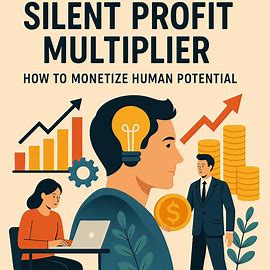THE SILENT PROFIT MULTIPLIER: HOW TO MONETIZE HUMAN POTENTIAL WITHOUT EXPLOITING IT
The measurable financial and psychological, and cultural return on every human investment the organization makes.
Savita Morale
10/18/20252 min read


THE SILENT PROFIT MULTIPLIER: HOW TO MONETIZE HUMAN POTENTIAL WITHOUT EXPLOITING IT
Human Profitability (HP) = The measurable financial and psychological return on every human investment the organization makes.
It’s not about headcount or salary cost.
It’s about how much value — tangible and intangible — each employee adds to business success, culture, and customer outcomes.
It combines three layers:
Economic Return: Contribution to revenue, cost efficiency, innovation.
Psychological Return: Engagement, emotional ownership, and alignment with organizational purpose.
Cultural Return: The ripple effect an employee has on morale, collaboration, and talent attraction.
If financial profit is the bloodstream of a business, human profitability is the oxygen that determines how far that blood can travel.
The Boardroom Mistake: Measuring Cost Instead of Capability
Traditional HR metrics (attrition, absenteeism, man-hours) are accounting figures — not strategy indicators.
When you treat employees as costs, your HR strategy becomes defensive — focused on control, not growth.
High-performing companies shift the equation:
“We don’t reduce cost per employee. We increase profit per employee.”
That’s why firms like Google or Netflix can pay above-market salaries and still outperform competitors — they treat human talent as profit centers, not expense lines.
The Psychology Behind Human Profitability
There’s a deep behavioral truth here:
People deliver their best not when they’re controlled, but when they’re trusted and recognized as value creators.
When an employee feels like an investor in the company’s success, rather than a laborer executing tasks, you ignite psychological ownership — the invisible force that multiplies performance.
It’s not about “employee happiness”; it’s about employee contribution with consciousness.
How to Measure Human Profitability
Start simple, but strategic:
Link KPIs to Business Outcomes
Don’t just measure attendance; measure how consistency improves delivery timelines.
Don’t just track training hours; track post-training revenue growth or process improvements.
Quantify Human Capital ROI
(Revenue – Non-HR Costs) ÷ Total HR Spend
Shows how efficiently HR investments drive overall business value.
Measure Emotional Equity
Track retention of high performers, peer recognition, internal referrals, innovation index — these reveal whether your culture is wealth-creating or draining energy.
Adopt ‘Profit per Human’ Dashboards
Integrate HR analytics with finance dashboards to visualize profitability per role.
Over time, this shifts HR’s perception from “soft function” to “strategic driver.”
Real-World Example: A Case from My Consulting Work
At one client site — a mid-sized manufacturing firm — I added Human Profitability Framework to the PMS (Performance Management System).
Each employee had three metrics: contribution to cost reduction, innovation ideas submitted, and team impact score.
Within 6 months:
Productivity rose by 27%
Attrition fell by 40%
The leadership finally understood which teams generated the highest ROI — not in cost, but in value.
When employees saw that profitability wasn’t just financial but human, they started taking pride in being assets, not resources.
“Human Profitability” isn’t a feel-good HR term. It’s a business weapon.
The moment leaders begin to calculate profit per human, the conversation between HR and the CEO transforms.
HR stops asking for budget.
It starts demanding investment — and proving returns.
Because in the end, machines may automate tasks, but humans multiply value.
And the companies that understand this truth will not just survive AI — they’ll profit from it.
Savita Morale
LABDHI HR
LABDHI HR STRATEGIES AND SERVICES
consultant@labdhihr.com
+91 8424815548
© 2024. All rights reserved.
Registered Office Address:
We Work,Oberoi, Goregaon East, Mumbai,Maharashtra,India-400063
